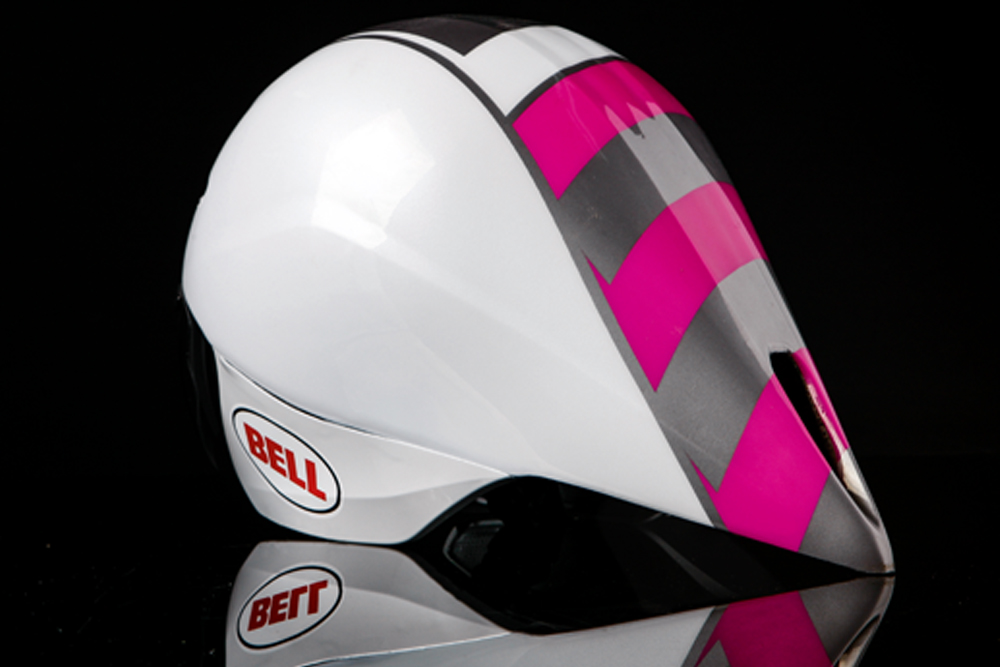Is a long-tailed aero helmet faster?
We weigh up the pros and cons of long-tailed versus short-tailed time trial helmets when racing against the clock

Aerodynamics play a greater role on an indoor track than in any other cycling discipline.
The helmets on display at the 2016 UCI Track World Championships ranged from short, stubby aero lids to classic teardrop-shaped helmets with long tails.
In road time trials, too, aero kit plays a big part in achieving the fastest times. So when choosing your headwear, should you go for a short or a long-tail?
Streamlined profile
Dr Chris Yu, aero and racing R&D lead at Specialized, explains: “A long-tailed TT helmet (assuming the shape is correctly designed) can be faster because aerodynamically speaking, a streamlined airfoil-like shape can be between 10-20 times lower in drag coefficient than a spherical shape.”
This is a view shared by aerodynamics expert Xavier Disley of Aerocoach. “The reason why longer-tailed helmets work is because the tail helps to keep airflow attached to your body for as long as possible,” he says.
>>> How to be more aero on your road bike (video)
A streamlined profile will reduce drag, meaning less resistance to your forward propulsion. Disley explains: “A seamless transition between the helmet and your back is the best way to achieve this, as when the airflow over your body separates it creates low pressure which slows you down.”
The latest race content, interviews, features, reviews and expert buying guides, direct to your inbox!
Standard road vs aero: what's the difference?
Real-world performance
Despite the purported benefits of long-tailed options, there are many shorter-tailed or stubby aero helmets on the market. A common view is that tail length should decrease as the event duration increases, because as fatigue sets in you cannot maintain the ideal head position.
Yu explains: “A long-tailed helmet can backfire in some cases where the helmet isn’t designed for certain head positions or is too finely optimised for a single head position — the longer tail could cause more drag than not having one at all.”
>>> Which aero kit gives the most bang for your buck? (video)
Fans of shorter-tailed helmets are quick to advocate their performance in real world conditions away from a controlled setting. “A short-tail design, combined with a dimpled shape, performs better [than a long-tailed helmet] when the winds shift and a rider’s position is dynamic rather than fixed,” says Jeff Schneider, gear global marketing for Giant bicycles.
Prime position
However, Schneider acknowledges that if a rider can maintain the ideal position then a long tail is the optimal design.
“In this situation, cyclists will benefit considerably from a longer-tail design.” Disley points out that every rider is different and ideally they should test a few helmets to find the best design for them.
>>> Aero bikes: a complete buyer’s guide
Assuming you’ve made the ideal choice, he confirms the aero advantage of a correctly fitting long-tailed helmet are substantial: “A shorter-tailed helmet or badly fitting helmet could cost you anything up to 10w or around 0.5kph when travelling at 40kph.”
Oliver Collins, Lazer product manager at Madison, believes Lazer’s ‘inclination sensor’ could be the answer. Recently approved by the UCI, the sensor notifies a rider when they move out of the optimum position. “The inclination sensor should help the rider maintain their perfect position,” says Collins.
Find the right helmet for you
Our take
If you can maintain the optimum position for the duration of the event, then a longer tail will be more aerodynamic. However, for many, holding an aerodynamic position is difficult; too much head movement and the tail will act like a kite, and negate any aero benefits. A stubby aero helmet could be the best all-round compromise for the majority of riders.
Is a long-tailed aero helmet faster?
Yes: Xavier Disley, Aerocoach
“A long-tailed helmet is faster and buying a short-tailed helmet is not the solution to moving your head around a lot during a race. The solution is to stop moving your head around! Learn to keep your head in a consistent position, this is not only more aerodynamic but also crucially much safer, as you should be looking up the road.”
No: Jeff Schneider, Gear Global Marketing for Giant bicycles
“Giant’s Computational Fluid Dynamics (CFD) simulations and third-party wind-tunnel tests prove that short-tail designs perform best in ‘real world’ conditions. As a result, Giant believes that for the larger percentage of riders, a short-tail design, like the Giant Rivet and Rivet TT, will offer superior aerodynamic benefits.”